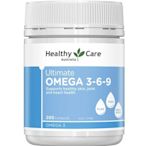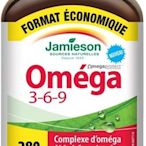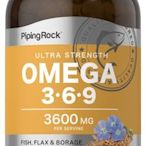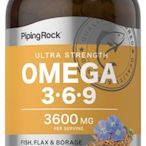搜尋結果
 $1050【Piping Rock】Omega 3-6-9 魚油-亞麻籽油-琉璃苣油 240顆我的健康食品 MY HEALTH FOOD
$1050【Piping Rock】Omega 3-6-9 魚油-亞麻籽油-琉璃苣油 240顆我的健康食品 MY HEALTH FOOD $790代購澳洲 Healthy Care Omega 3-6-9 (200顆)Double Sister
$790代購澳洲 Healthy Care Omega 3-6-9 (200顆)Double Sister $320100%印加果油膠囊 30粒/500毫克 具有養顏美容 調整體質之作用 含omega-3.6.9 效期202507Y0881306916
$320100%印加果油膠囊 30粒/500毫克 具有養顏美容 調整體質之作用 含omega-3.6.9 效期202507Y0881306916 $329德國 好立善 Omega 3-6-9 必需脂肪酸 魚油+亞麻仁油+月見草油 (60粒)購物中心
$329德國 好立善 Omega 3-6-9 必需脂肪酸 魚油+亞麻仁油+月見草油 (60粒)購物中心![♚夏夏海外精品♚HB英國荷柏瑞深海魚油120粒omega-3-6-9 ♚夏夏海外精品♚HB英國荷柏瑞深海魚油120粒omega-3-6-9]() $1350♚夏夏海外精品♚HB英國荷柏瑞深海魚油120粒omega-3-6-9♚夏夏海外精品♚
$1350♚夏夏海外精品♚HB英國荷柏瑞深海魚油120粒omega-3-6-9♚夏夏海外精品♚![小紫瓶🌿天然Omega-3-6-9亞麻籽油🌿180粒 小紫瓶🌿天然Omega-3-6-9亞麻籽油🌿180粒]() $780小紫瓶🌿天然Omega-3-6-9亞麻籽油🌿180粒德國生活百貨
$780小紫瓶🌿天然Omega-3-6-9亞麻籽油🌿180粒德國生活百貨![現貨! Jamieson OmegaProtect Omega 3-6-9 - Value Size 加大包裝280顆 現貨! Jamieson OmegaProtect Omega 3-6-9 - Value Size 加大包裝280顆]() $1050現貨! Jamieson OmegaProtect Omega 3-6-9 - Value Size 加大包裝280顆The Beauty Bar 漂亮吧!
$1050現貨! Jamieson OmegaProtect Omega 3-6-9 - Value Size 加大包裝280顆The Beauty Bar 漂亮吧!![德國 好立善 Omega 3-6-9 必需脂肪酸 魚油+亞麻仁油+月見草油 (60粒/盒)(效期2025/03/31) 德國 好立善 Omega 3-6-9 必需脂肪酸 魚油+亞麻仁油+月見草油 (60粒/盒)(效期2025/03/31)]() $255德國 好立善 Omega 3-6-9 必需脂肪酸 魚油+亞麻仁油+月見草油 (60粒/盒)(效期2025/03/31)Y6959722090
$255德國 好立善 Omega 3-6-9 必需脂肪酸 魚油+亞麻仁油+月見草油 (60粒/盒)(效期2025/03/31)Y6959722090![【活力小站】Piping Rock Omega 3-6-9 魚油-亞麻籽油-琉璃苣油 240顆 【活力小站】Piping Rock Omega 3-6-9 魚油-亞麻籽油-琉璃苣油 240顆]() $1050【活力小站】Piping Rock Omega 3-6-9 魚油-亞麻籽油-琉璃苣油 240顆Y5125069859
$1050【活力小站】Piping Rock Omega 3-6-9 魚油-亞麻籽油-琉璃苣油 240顆Y5125069859![【天然小舖】Piping Rock Omega 3-6-9 魚油-亞麻籽油-琉璃苣油 240顆 【天然小舖】Piping Rock Omega 3-6-9 魚油-亞麻籽油-琉璃苣油 240顆]() $1000【天然小舖】Piping Rock Omega 3-6-9 魚油-亞麻籽油-琉璃苣油 240顆Y8850095926
$1000【天然小舖】Piping Rock Omega 3-6-9 魚油-亞麻籽油-琉璃苣油 240顆Y8850095926![德國 好立善 Omega 3-6-9 必需脂肪酸 魚油+亞麻仁油+月見草油 3入組 (60粒x3盒) 德國 好立善 Omega 3-6-9 必需脂肪酸 魚油+亞麻仁油+月見草油 3入組 (60粒x3盒)]() $899德國 好立善 Omega 3-6-9 必需脂肪酸 魚油+亞麻仁油+月見草油 3入組 (60粒x3盒)購物中心
$899德國 好立善 Omega 3-6-9 必需脂肪酸 魚油+亞麻仁油+月見草油 3入組 (60粒x3盒)購物中心![北京同仁堂 黃金聖果沙棘籽油軟膠囊 (胡蘿蔔素 維他命C Omega 3、6、9) 60粒/瓶 專品藥局【2028617】 北京同仁堂 黃金聖果沙棘籽油軟膠囊 (胡蘿蔔素 維他命C Omega 3、6、9) 60粒/瓶 專品藥局【2028617】]() $1620北京同仁堂 黃金聖果沙棘籽油軟膠囊 (胡蘿蔔素 維他命C Omega 3、6、9) 60粒/瓶 專品藥局【2028617】【專品藥局】P&Q實體店面
$1620北京同仁堂 黃金聖果沙棘籽油軟膠囊 (胡蘿蔔素 維他命C Omega 3、6、9) 60粒/瓶 專品藥局【2028617】【專品藥局】P&Q實體店面
其他人也問了
What are omega-3 fatty acids?
What is the ratio of omega-6 to omega-3 fatty acids?
What are the side effects of omega-3 fatty acids?
Is inflammation a tightrope walk between omega-6 and omega-3 fatty acids?
Omega−3 fatty acids, also called Omega−3 oils, ω−3 fatty acids, Ω-3 Fatty acids or n−3 fatty acids, [1] are polyunsaturated fatty acids (PUFAs) characterized by the presence of a double bond, three atoms away from the terminal methyl group in their chemical structure. [2] They are widely distributed in nature, being important ...
Omega−3 fatty acids are important for normal metabolism. [2] Mammals are unable to synthesize omega−3 fatty acids, but can obtain the shorter-chain omega−3 fatty acid ALA (18 carbons and 3 double bonds) through diet and use it to form the more important long-chain omega−3 fatty acids, EPA (20 carbons and 5 double bonds) and then from EPA, the most crucial, DHA (22 carbons and 6 double ...
- Uses
- Food Sources
- Health Effects
- Supplements
- Dangers
- Notes
- External Links
Often marketed and sold for consumption as part of the diet or in dietary supplements in contemporary societies, fish oils also have found roles in external use, as emollientsor as general ointmentsas well as in body art,or for alleged insulation against cold temperatures.
The most widely available dietary source of EPA and DHA is cold-water oily fish, such as salmon, herring, mackerel, anchovies, and sardines. Oils from these fish have a profile of around seven times as much omega-3 oils as omega-6 oils. Other oily fish, such as tuna, also contain omega-3 in somewhat lesser amounts. Although fish is a dietary source...
History
Fish oil became one of the earliest dietary supplements, and by the end of the 19th century, was used as a treatment for many diseases, including such ailments as tuberculosis and hysteria. The possible effects of fish oil and omega-3 fatty acids have since been studied in clinical depression, anxiety, cancer, and macular degeneration, yet they have not been proven effective.
Various recommendations
In a 2009 letter on a pending revision to the Dietary Guidelines for Americans, the American Heart Association recommended 250–500 mg/day of EPA and DHA. The Guidelines were revised again for 2015–2020; included is a recommendation that adults consume at least eight ounces of a variety of types of fish per week, equating to at least 250 mg/day of EPA + DHA.[citation needed]The Food and Drug Administration recommends not exceeding 3 grams per day of EPA + DHA from all sources, with no more tha...
Prostate cancer
The effect of fish oil consumption on prostate cancer is controversial. For instance, one study showed decreased risk with higher blood levels of DPA. However, another reported increased risk of more aggressive prostate cancer with higher blood levels of combined EPA and DHA.Some evidence indicated an association between high blood levels of omega-3 fatty acids and an increased prostate cancer risk. However, this evidence from the Select Trial has been challenged on the grounds of methodology...
Fish oil is a commonly used dietary supplement, with sales in the US alone reaching $976 million in 2009.By 2020 the global omega-3 supplement market size had reached $5.58 billion, and fish oil based supplements accounted for 63.1% of that market.
A 2013 review concluded that the potential for adverse events among older adults taking fish oil "appear mild–moderate at worst and are unlikely to be of clinical significance".
Omega-3 fish oil supplements have no standard doses and vary considerably by producers and producers' products, but salmon oil consistently has more DHA than EPA while other fish oils have more EPA...Plant-based omega-3s are rich in ALA but completely lack EPA and DHA, so vegetarians and vegans seeking non-fish sources turn to more expensive algae derived oils. There is generally a pattern of m...International Fish Oil Standards Archived 29 March 2019 at the Wayback Machine – An organization concerned with the quality of omega-3 products as it relates to the international standards establis...Joyce A. Nettleton (ed.). "PUFA Newsletter". Retrieved 20 February 2006.Two newsletters, both quarterly, reviewing recent publications in essential fatty acids. One is written for researchers, the...Fatty acid ratio in food. Only two essential fatty acids are known to be essential for humans: alpha-linolenic acid (an omega-3 fatty acid) and linoleic acid (an omega-6 fatty acid ). [1] The biological effects of the ω-3 and ω-6 fatty acids are mediated by their mutual interactions.
Two types of fatty acids considered essential for human health are the omega-3 and omega-6 types. These two essential fatty acids are necessary for some cellular signalling pathways and are involved in mediating inflammation, protein synthesis, and in the
Mechanism of action. Omega-3-acid ethyl esters, like other omega-3 fatty acid-based drugs, appears to reduce production of triglycerides in the liver and to enhance clearance of triglycerides from circulating very low-density lipoprotein (VLDL) particles.
Omega-3 carboxylic acids [1] ( Epanova) is a formerly marketed yet still not an Food And Drug Administration (FDA) approved prescription medication–since taken off market by the manufacturer–used alongside a low fat and low cholesterol diet that lowers high triglyceride (fat) levels in adults with very high levels. [2]








